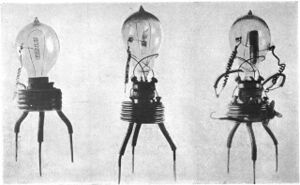Fleming valve (nonfiction): Difference between revisions
No edit summary |
No edit summary |
||
| (One intermediate revision by the same user not shown) | |||
| Line 20: | Line 20: | ||
<gallery> | <gallery> | ||
File:Liquid Chitty-Chitty-Bang-Bang.jpg|link=Liquid Chitty-Chitty-Bang-Bang|"[[Liquid Chitty-Chitty-Bang-Bang]]" (LCCBB) | File:Liquid Chitty-Chitty-Bang-Bang.jpg|link=Liquid Chitty-Chitty-Bang-Bang|"'''[[Liquid Chitty-Chitty-Bang-Bang]]'''" ('''LCCBB''') is a downloadable, user-reprogrammable cologne. The bottle's distinctive automobile design has an unusual feature — two decorative spare tires which conceal a Fleming valve. When activated, the valve emits "putt-putts" of non-Euclidean cologne. | ||
File:Fleming valves.jpg|Union leaders from [[Fleming Valve Local #1]] representing the cast and crew of [[Dance of the Fleming Valves]] demand to meet with management, negotiate terms for a share of the profits from [[Liquid Chitty-Chitty-Bang-Bang]]. | File:Fleming valves.jpg|Union leaders from [[Fleming Valve Local #1]] representing the cast and crew of [[Dance of the Fleming Valves]] demand to meet with management, negotiate terms for a share of the profits from [[Liquid Chitty-Chitty-Bang-Bang]]. | ||
Latest revision as of 05:51, 21 July 2021
The Fleming valve, also called the Fleming oscillation valve, was a thermionic valve or vacuum tube invented in 1904 by Englishman John Ambrose Fleming as a detector for early radio receivers used in electromagnetic wireless telegraphy. It was the first practical vacuum tube and the first thermionic diode, a vacuum tube whose purpose is to conduct current in one direction and block current flowing in the opposite direction.
The thermionic diode was later widely used as a rectifier — a device which converts alternating current (AC) into direct current (DC) — in the power supplies of a wide range of electronic devices, until beginning to be replaced by the selenium rectifier in the early 1930s and almost completely replaced by the semiconductor diode in the 1960s. The Fleming valve was the forerunner of all vacuum tubes, which dominated electronics for 50 years.
The IEEE has described the Fleming valve as "one of the most important developments in the history of electronics", and it is on the List of IEEE Milestones for electrical engineering.
On June 4, 1903, magician and inventor Nevil Maskelyne disrupted Fleming's public demonstration of Guglielmo Marconi's purportedly secure wireless telegraphy technology, sending insulting Morse code messages through the auditorium's projector. This is an early example of hacking.
Sungook Hong has written a critical analysis of Fleming's work:
Fleming's recollection of the invention of the valve can be characterized by the continuity of the device to his previous work (the Edison effect), as well as by the radical discontinuity between his and others' work. He stressed his 'scientific' research on the Edison effect that he had conducted in the 1880s and 1890s, the importance of his role as scientific advisor to Marconi, and the demand for new detectors around 1904, as well as the valve's straightforward use as a sensitive detector when it was invented.
However, I have revealed complexities and contingencies behind this neat story of Fleming. The invention turns out to have more to do with local and temporal resources specifically available to Fleming in the fall of 1904, than his long-term research on the Edison effect or the putative high demand for new detectors for wireless telegraphy. I argued that the combination of heterogeneous factors such as Fleming's previous research on the measurement of high-frequency alternating current by rectification, Fleming's dismissal from the Marconi Company at the end of 1903, Nodon's electrolytic valve publicized by the Electrician in October 1904, and the electron theory formed technical, material, conceptual, and linguistic resources that Fleming mobilized in a timely manner.
I also tried to show that the use of the valve was not clearly defined in 1904. Fleming intended it to be a measuring instrument, a meter. Its irregular and nonlinear current-voltage characteristics made it very difficult to use the device as a meter. As a detector, it was less sensitive than other detectors. But it had a social use. It was successfully exploited to revive Fleming's severed connection to the Marconi Company. As a detector, it remained auxiliary until Marconi connected a telephone and a jigger to the valve circuit. I have also shown that Fleming became much concerned about his credit as the inventor of the valve when de Forest depreciated Fleming's originality. The 'canonical' story about the invention of the valve was first remembered by Fleming when he was deeply engaged in a lawsuit with de Forest.
In the News
"Liquid Chitty-Chitty-Bang-Bang" (LCCBB) is a downloadable, user-reprogrammable cologne. The bottle's distinctive automobile design has an unusual feature — two decorative spare tires which conceal a Fleming valve. When activated, the valve emits "putt-putts" of non-Euclidean cologne.
Union leaders from Fleming Valve Local #1 representing the cast and crew of Dance of the Fleming Valves demand to meet with management, negotiate terms for a share of the profits from Liquid Chitty-Chitty-Bang-Bang.
Fiction cross-reference
- AESOP - TO_DO - research
- Crimes against physical constants
- Dance of the Fleming Valves - TO_DO - research
- Fleming Valve Local #1 - TO_DO - research
- Gnomon algorithm
- Gnomon Chronicles
Nonfiction cross-reference
- Diode (nonfiction)
- Edison effect (nonfiction)
- Electricity (nonfiction)
- John Ambrose Fleming (nonfiction)
- Maskelyne-Marconi affair (nonfiction)
External links
- Fleming valve @ Wikipedia
- Inventing the History of on Invention: J. A. Fleming's Route to the Valve by Sungook Hong (PDF)
- Wireless: From Marconi's Black-box to the Audion by Sungook Hong


